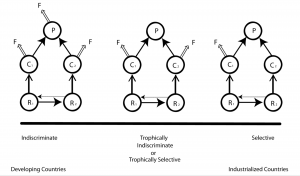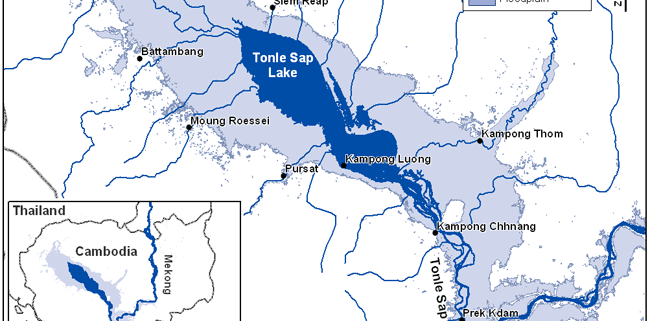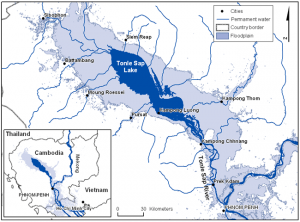Ecological Impacts of Indiscriminate Fisheries
By Hannah Calich, SRC Graduate Student
When people think of fisheries they tend to think of species-selective fisheries, such as swordfish or tuna fisheries. However, many fisheries do not focus on a particular species and will harvest most of the fish they catch; these are known as indiscriminate fisheries (McCann et al., 2016). While indiscriminate fisheries can be found globally, they are particularly common in developing countries where fish are the primary source of protein. Understanding the ecological impacts of these fisheries is difficult due to the complex food web interactions that occur when multiple species and sizes are harvested at the same time. In order to understand how susceptible these fisheries are to human activities, methods must be developed to model these complex interactions.
To better understand the ecological impacts of indiscriminate fisheries, McCann et al. (2016) developed food web models to predict how ecosystems may respond to different types of fishing pressure. The authors compared indiscriminate fisheries to trophically selective fisheries, which only target species within a tropic level (e.g., consumers) and selective fisheries, which only target specific species (e.g., snapper; Figure 1). With these models the authors were able to develop a set of rules to predict how ecosystems may respond to different types of fishing pressure.

Figure 1. The three fishing strategies examined in this study are indiscriminate (left), trophically selective (middle), and selective (right). The symbols R, C, P and F stand for resources (e.g., seagrass), consumers (e.g., parrotfish), predators (e.g., sharks) and fishing mortality, respectively.
McCann et al. (2016) created three rules to predict how ecosystems may respond to indiscriminate fisheries.
Rule 1. Fishing down the food web.
In indiscriminate and trophically selective fisheries, top predators are removed from the ecosystem through direct harvest or a decrease in prey availability (i.e., if too many prey species are harvested the top predators may starve).
Rule 2. Fishing across food webs.
High fishing pressure within a trophic level results in fast-growing species becoming dominant. When fast-growing species no longer have to compete with slow-growing species for resources they can quickly increase in numbers.
Rule 3. Fishing down and across food webs.
When indiscriminate fisheries fish down and across food webs, top predators are removed and slow-growing species are replaced with fast-growing species. While an increase in fast-growing fish increases system production, it also decreases community-level stability due to a decrease in diversity.
To determine if these rules can be applied to a real-life scenario, McCann et al. (2016) examined the Tonlé Sap ecosystem in Cambodia, which has a highly productive indiscriminate fishery (Figure 2). Tonlé Sap has experienced a steady increase in fishing intensity over time, which has resulted in a loss of top predators. The authors determined that the mean size of the species “at risk” within the ecosystem was nearly twice that of the species “of least concern” (i.e., the faster growing, smaller-bodied species have more stable populations). Consistent with the author’s predictions, this ecosystem appears to have lost top predators and slow-growing consumers but is still productive due to an increase in small, fast-growing species.
Overall, indiscriminate fishing reduces the abundance of top predators, depletes slow-growing species, and increases the number of fast-growing species while reducing ecosystem diversity. These shifts can leave ecosystems vulnerable to changing environmental conditions such as climate change or hydroelectric development. This study emphasizes the importance of incorporating ecosystem structure into fisheries management because trends in species abundance may be misinterpreted if an ecosystem is not well understood (e.g., an increase in fast-growing fish abundance may be interpreted as a positive change when it may actually indicate a decrease in ecosystem diversity and stability).
Reference:
McCann K.S., Gellner, G., McMeans, B.C., Deenik, T., Holtgrieve, G., Rooney, N., Hannah, L., Cooperman, M., Nam, S. (2016). Food webs and the sustainability of indiscriminate fisheries. Canadian Journal of Fisheries and Aquatic Science. 73:1-10.





Leave a Reply
Want to join the discussion?Feel free to contribute!